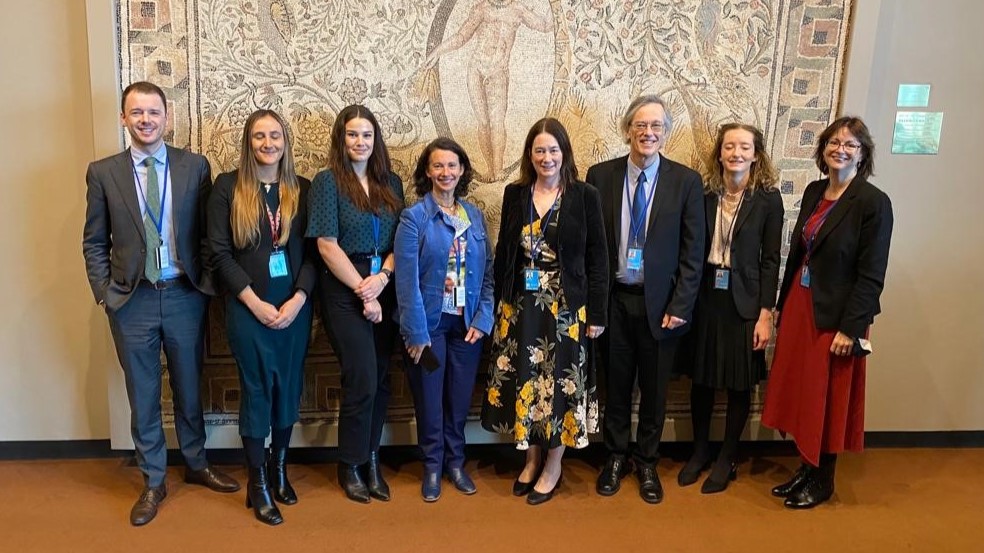
From left to right: Luke Roughton (MFAT), Hilary Aryton (Ministry of Primary Industries), Abby Hutchison (ex-MFAT), Alexandra Macdonald (Department of Conservation), Victoria Hallum (MFAT), Barry Weeber (ECO), Zoe Russell (MFAT), Joanna Mossop (Victoria University of Wellington). Credit: MFAT.
Biodiversity concerns the health of all living things and their ecosystems, and is crucial to the maintenance of human life on earth. However, global biodiversity is increasingly at risk. An estimated 25 percent of the world’s animals and plant groups are threatened, and one million species are facing extinction. In New Zealand, more than 4,000 species face extinction, including precious taonga. This is the fastest rate of extinction in human history, and is unprecedented since the extinction of the dinosaurs.
The year 2022–23 saw two breakthrough achievements in the international stewardship of global biodiversity and the oceans. On 4 March 2023, agreement was reached on a new treaty on the conservation and sustainable use of ocean biological diversity in areas beyond national jurisdiction. The new treaty builds on the existing framework created by the UN Convention on the Law of the Sea (UNCLOS) and is a demonstration of what countries can achieve by working together through the UN.
When UNCLOS was negotiated four decades ago, the importance of biodiversity was not well understood. The new treaty strengthens international stewardship of the oceans and high seas biodiversity by providing tools and systems for their management and protection, including the creation of marine protected areas, and sets clear procedures and requirements for assessing environmental impacts. In doing so, it takes a coherent approach to oceans governance and reinforces the roles of existing institutions, frameworks, and bodies, such as Regional Fisheries Management Organisations and the Antarctic Treaty System. The treaty also facilitates the full and effective participation of developing countries – including Pacific Island states – in the conservation and sustainable use of marine biodiversity, and in the sharing of knowledge from marine genetic resources. New Zealand’s negotiating team worked hard to secure these outcomes, including to: ensure effective procedures for establishing marine protected areas; ensure proposals for their establishment could not be blocked; and to include provision for emergency measures to be imposed in response to unexpected disasters. We also chaired negotiations on the Implementation, Compliance and Dispute Settlement chapters, and on the Area Based Management Tools chapter at an earlier stage in the negotiations. In December 2022, the much-anticipated global deal for nature, the Kunming-Montreal Global Biodiversity Framework (GBF), was adopted by the 15th Conference of Parties (COP15) to the Convention on Biological Diversity (CBD). COP15 was scheduled for 2020, but was postponed due to the COVID-19 pandemic. The GBF replaces the Strategic Plan for Biodiversity 2011–20 and Aichi Targets agreed in 2010.
Our objectives for the GBF were to secure ambitious outcomes containing evidence-based goals and targets that address the drivers of biodiversity loss, as well as strong outcomes on indigenous rights. Our negotiators played active leadership roles, including on the Bureau and by chairing one of two Working Groups at COP15. The new global goals are ambitious. A key outcome was agreement on the ‘30x30’ conservation target, which aims to ensure 30 percent of terrestrial and inland water, and of coastal and marine areas, are effectively conserved and managed by 2030. This is a significant increase from previous targets, which aimed to protect 17 percent of land and 10 percent of coastal and marine areas. Parties also agreed to mobilise annual funding of USD$200 billion from all sources (including private) by 2030 to support implementation. The focus now shifts to effective implementation, to ensure global biodiversity loss is halted and reversed by 2030.

